The Intel Lakefield Deep Dive: Everything To Know About the First x86 Hybrid CPU
by Dr. Ian Cutress on July 2, 2020 9:00 AM ESTA Stacked CPU: Intel’s Foveros
The previous designs of Intel, AMD and Qualcomm are what we call monolithic designs – everything on the processor happens on a single piece of physical silicon. When everything is on a single piece of silicon, it makes data management inside the processor a lot easier and simpler, it makes designing the processor a lot simpler, and manufacturing and assembly can be streamlined when only dealing with one physical element to the processor.
However, there have been moves in the industry to deviate from these single monolithic designs, as the benefits of trying something different are starting to offer beneficial points of differentiation within a product portfolio. It can lead to optimizations on different parts of the processor, it can be advantageous for cost reasons, and it also can expand silicon products beyond traditional manufacturing limits as well.
Monolithic vs Chiplets
You may be aware that recent AMD desktop processors are built on a ‘chiplet’ design. This is where multiple pieces of silicon are connected through wires in the green PCB in order to create a single ‘processor’. By using separate chiplets, each individual chiplet can either be focused on a single task (and be manufactured in the most efficient way for that task) or it can be a one of a repeated unit designed to scale out the compute performance.
For example, a processor core that contains logic circuits might aim for performance, and thus might require a very speed optimized layout. This has different manufacturing requirements compared to something like a USB controller, which is built to a series of specifications as per the USB standard.
Under a traditional monolithic regime, the single piece of silicon will use a singular manufacturing process that has to be able to cater for both situations – both the processor core logic and the USB controller. By having different parts of the overall design separated in different pieces of silicon, each one optimized for the best manufacturing scenario. This only works as long as the connectivity between the chips works, and it potentially enables a better mix of performance where you need it, and better efficiency (or cheaper cost) where you need it as well.
Of course, there are trade-offs: additional connectivity is required, and each chiplet needs to be able to connect to other chiplets – the total physical design area of the combined chiplets is often greater than what a single piece of silicon would offer because of these connectivity additions, and it could become costly to assemble depending on how many parts are involved (and if those parts are manufactured in different locations). Ultimately, if some chiplets are on an expensive manufacturing process, and some are on a cheaper manufacturing process, then we get the benefits of the expensive process (power, performance) without having to spend the money to build everything on that process, overall saving money.
One other benefit that a chiplet process can bring is total silicon size of the product. Standard monolithic silicon designs, due to the manufacturing process technologies we use today, have an upper bound of how big a single piece of silicon can be. By implementing chiplets, suddenly that upper limit isn’t much of a concern unless each chiplet reaches that limit - using multiple chiplets can give a total silicon area bigger than a single monolithic chip design. An example of this is AMD’s Rome CPUs, which total an area of over 1000 square millimetres, while the single largest monolithic silicon die is NVIDIA’s A100 GPU, coming in at 826 square millimetres.
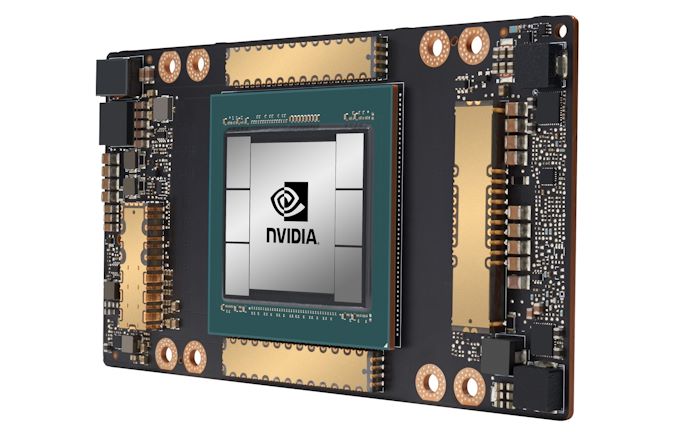
NVIDIA's A100 GPU, with one big monolithic die and six high bandwidth memory dies.
Already in Market: AMD Chiplets
To put this into context of a modern design, AMD’s Ryzen processors use one or more ‘compute chiplets’ combined with a single ‘peripheral’ chiplet (often called an IO die). The compute chiplets are built on TSMC’s high-performance 7nm manufacturing node which extracts peak performance and power from the design. The ‘peripheral’ chiplet, which is not so peak performance focused but more tuned to standards like SATA, PCIe and USB, can be built on a manufacturing node where efficiency is more important, and also the cost can be lower, such as GlobalFoundries’ cheaper 14nm manufacturing node. Put together, these chiplets form a singular product.
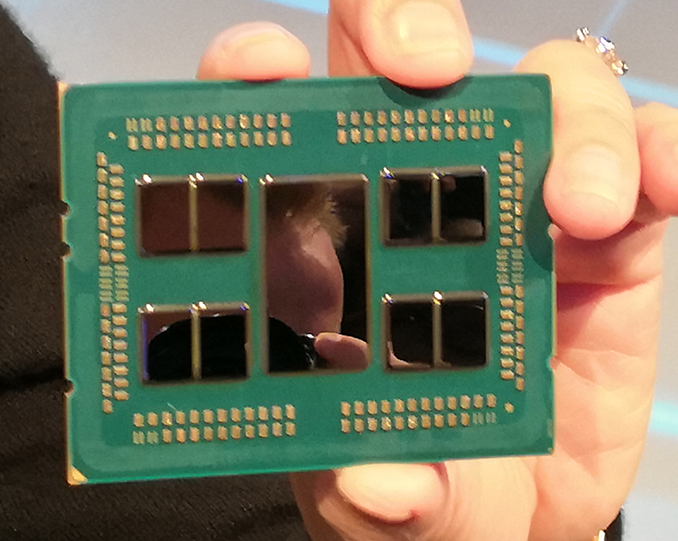
AMD's Rome with 1 big IO die and eight compute dies
AMD had to overcome a lot of hurdles to get here, such as developing a chip-to-chip connectivity standard (known as Infinity Fabric), managing the power of the connectivity, but also physical manufacturing, such as ensuring all the individual chiplets match the same height for the heatspreader and cooler that goes on top to be effective.
One of the benefits of AMD going this route, according to the company, is that it allows them to scale the parts of their design that are easiest to scale for performance (the compute cores), and also manage where they think the future of compute is going. The other big benefit is that total die size of one of AMD’s server CPUs is larger than what can be manufactured in a single piece of silicon.
This sort of chiplet based approach also lends people to believe that AMD could swap out a compute based chiplet for a graphics based chiplet, or an AI-focused chiplet, and thus AMD could in the future offer different variants of its products depending on customer requirements for different workloads that the organization might have.
Coming to Market: Intel Chiplets
For Lakefield, Intel also goes down the chiplet route. But instead of placing the chiplets physically alongside each other like AMD, the chiplets are stacked on top one another. This creates a physically smaller processor package in the x-y dimensions, which is a critical component for laptop and small form factor mobile designs that Lakefield is aiming towards.
This stacked design replaces the tradeoff of physical space for one of cooling. By placing two high-powered bits of silicon on top of each other, managing thermals becomes more of an issue. Nonetheless, the physically smaller floorplan (along with a design focused to embed more control into the processor) in the x-y directions helps build thinner and lighter systems.
For the two stacked chiplets in the middle, the top chiplet is built on Intel’s high-performance 10nm+ manufacturing node and contains the 1+4 compute core configuration, as well as the graphics and the memory controller. The bottom chiplet contains the ‘peripheral’ components that are not as performance related, such as security controller, USB ports, and PCIe lanes. This is built on Intel’s cheaper 22nm manufacturing node.
Because this chiplet is on the bottom and has connections for power to pass through, Intel technically calls the lower chiplet an ‘active interposer’. An interposer is a term commonly used when chiplets are connected through a base piece of silicon, rather than through a green package PCB, because it allows communication between chiplets to be faster and more efficient, but it is a more expensive implementation.
What makes it an active interposer, rather than the passive interposers we have seen on some GPUs in recent years, is that it contains functional logic, such as the USB ports, the security, the chipset functions, and others. The passive interposers are just connection passthroughs, taking advantage of faster signaling. Active interposers include functional logic and have an associated power consumption that goes along with that.
The reason I bring this up is because there is some debate as to whether an active interposer is true 3D stacking as traditionally interpreted, or more akin to 2.5D stacking, which is what we commonly call a passive interposer. For those users who read more about Lakefield beyond AnandTech, you are likely to see both used.
Getting Stacked: DRAM and NAND vs Lakefield
The use of stacking is not necessarily new to the world of semiconductors. Both computer random access memory, such as DRAM, and storage components, such as NAND Flash, have implemented multiple layer technology for many years. What makes these elements different is the way they are stacked, plus also the power of the components involved.
The two main ways of stacking silicon together are through simple wire bonding, where the layers are not directly connected, or with Through Silicon Vias (TSVs), which are akin to stacks running through the layers.
This is an image of Samsung’s NAND wire bonding technique, where multiple layers have separate connections to a base die. There is no direct connection between layers other than the act of physically coming together.
This is ‘Through Silicon Via’ (TSV) stacking, whereby each layer has a vertical channel that connects to the die above and below it. It allows for direct connection through the stack for fast access, which is useful when NAND has 64 or more layers. It can be quite difficult to do as well, but NAND manufacturers are experts in this methodology.
However, DRAM and NAND Flash are not the high-powered elements of a computer. Even the most dense memory configurations look to contribute single digit of milliwatts of power per layer when in use. Applying these techniques to high-powered computer chips is a bit more complex.
Stacking with Lakefield
What Intel is doing with Lakefield, with its stacking, is putting together multiple layers of high-performance compute into a single product. Also, while most DRAM and NAND Flash implementations stack silicon on top of each other, and then use external wire bonding or TSVs, to provide connectivity - for Intel’s Lakefield, the connectivity goes through the silicon, as with a traditional interposer (as mentioned above), and uses a die-to-die bonding to provide the communications.
Intel calls its stacking technology ‘Foveros’. It uses a novel design of die-to-die connectivity.
At the bottom is the base packaging material that connects all the signals going out into the system (power, USB, display). On top of this is the base silicon peripheral die, the active interposer, containing things like the USB control, storage control, security, and such.
Between the base silicon peripheral die and the top logic compute die is a method of connecting the two, in this case we have a solder ball array with a 50 micron pitch. This is essentially a ‘balls-on-balls’ technique, but with two silicon dies of different process node manufacturing techniques.
These connections will come in three flavors: structural, data, and power. Creating these bumps and ensuring they deliver what is intended is a hard problem – electrical issues, such as capacitance, and computational issues, such as maintaining a clock frequency, have to be managed, along with achieving targets in data rate bandwidth as well as power.
Here is the main introduction slide that Intel presented at the ISSCC conference regarding the die-to-die interface. Unfortunately these were the quality of the pictures as presented (the unreadable aspect ratios are also native to the presentation).
As mentioned, maintaining the clock coherency at speed and low power is a concern, and here’s what Intel did, with each connection operating at 500 mega-transfers per second. The key point on this slide is the power: 0.2 picojoules of energy consumed per bit transferred. If we extrapolate this out to a memory bandwidth of 34 GBps (maximum memory bandwidth of Lakefield), this equates to 54 millwatts of power for the data transfer.
0.2 pJ/bit is one of the benefits of keeping the transmission of the data ‘inside’ the silicon, but moving between the two layers. This is an order of magnitude better than the numbers quoted by AMD for its first generation EPYC server processors, which used data transfer links within the CPU package – AMD quoted 2 pJ/bit transfer by comparison.
Here’s a slide from Intel’s 2018 Hot Chips talk about new data transfer and connectivity suggestions. On the left is the ‘on-board’ power transfer through a PCB, which runs at 20 pJ/bit. In the middle is on-package data transfer, akin to what AMD did with 1st Gen EPYC’s numbers, around 1-5 pJ/bit (depends on the technique), and then we get on-silicon data movement, which is more 0.1 pJ/bit. Intel’s Foveros die-to-die interconnect is most like the latter.



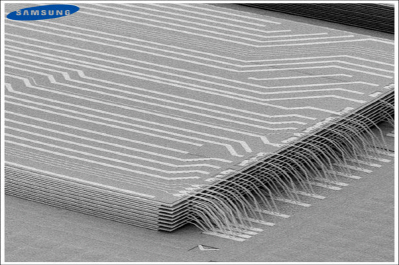
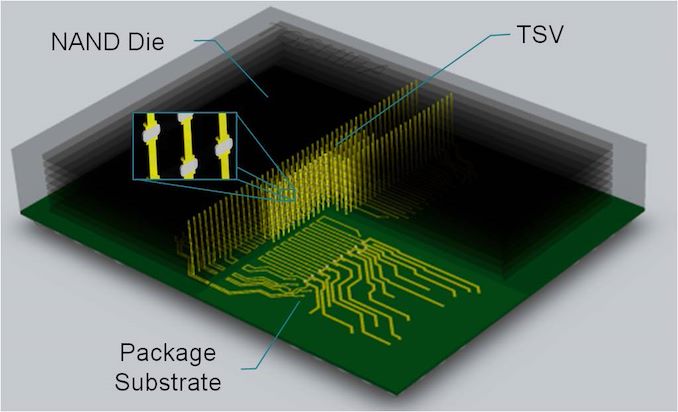
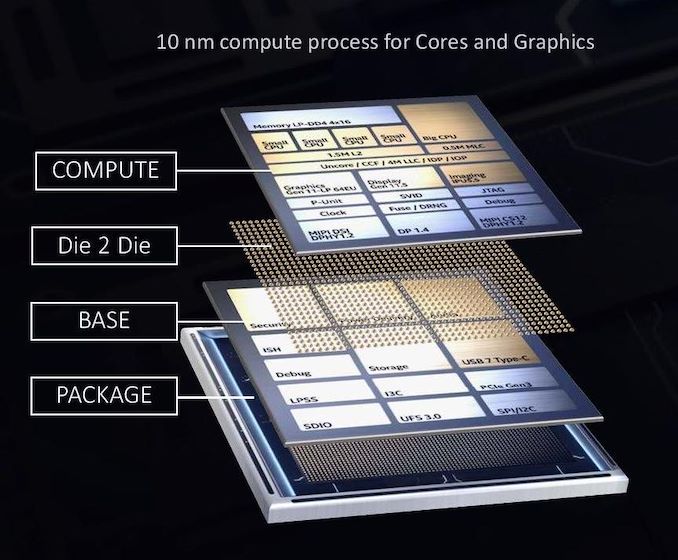
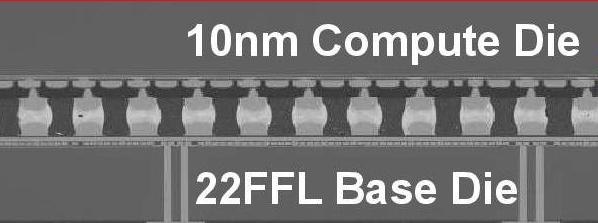
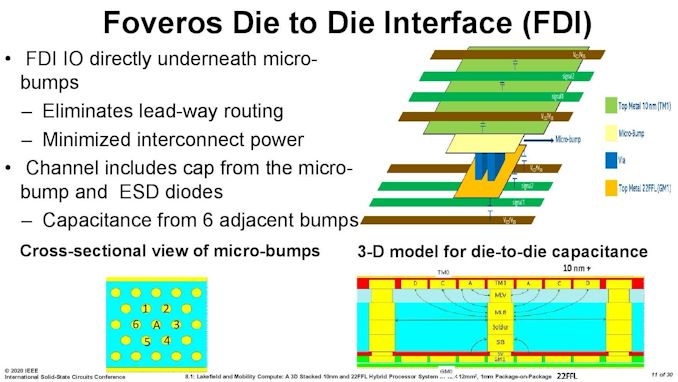
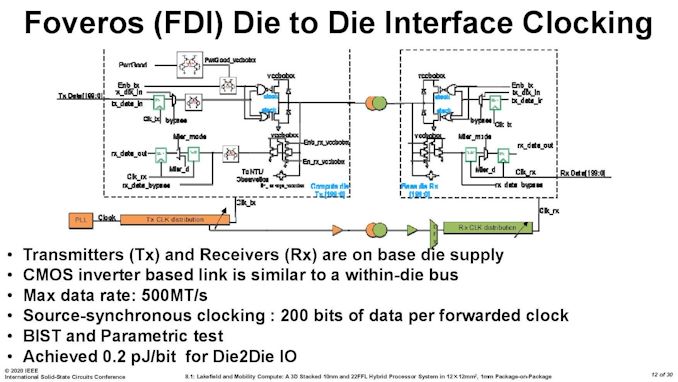
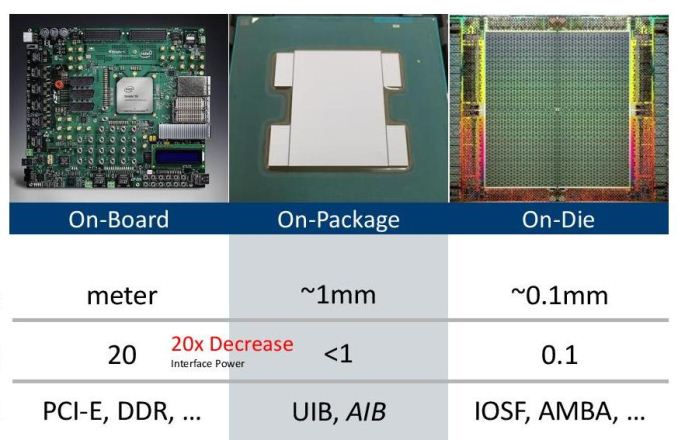








221 Comments
View All Comments
ichaya - Sunday, July 12, 2020 - link
You've claimed ARM64 has a code density advantage without any evidence for a few posts now. Being byte-aligned has advantages too, which are clear in the paper with the real world program! You're welcome to provide more real world evidence!We're changing the goal posts now with new numbers, you can't estimate IPC based on one specific INTrate2006 test, and assume it's similar across other workloads as well. If we just stick to INTrate2006, IPC seems within 5% where Graviton 2 has twice the cache of AMD Epyc 7742.
Comparing a top-line power number like you were doing is irrelevant when features like AVX can easily blow past any power envelope you might have, and one chip lacks the feature.
Wilco1 - Sunday, July 12, 2020 - link
No, I am stating that AArch64 has better code density as a fact. Maybe 5 years ago you could argue about it as AArch64 was still relatively new, but today that's not even disputable. So check it out if you'd like to see it for yourself.I used the overall intrate result to get an accurate IPC comparison. If you do the math correctly you'll see that Graviton 2 has 12% higher IPC than EPYC 7742.
At the end of the day what matters is performance, perf/W and cost. Whether you have AVX or not is not relevant in this comparison - EPYC 7742 uses the same amount of power whether it executes AVX code or not.
ichaya - Tuesday, July 14, 2020 - link
This is not the first time I've seen someone look at single thread performance and disregard everything else. All Graviton 2 and A13 single thread gains can be attributed to large (100~200% more) shared L2/L3 caches, and when compared with x86, 5% or even 75% IPC gains turn out to be ~10% less real world performance or ~10% more with marginal power use difference on 7nm. AMD has everything from a 15W to 280W chip.For multi-threaded, the Graviton 2 looks better, but the 64 vcpu EPYC 2 c5a.16xlarge (144MB L2+L3) AWS instance costs the same as the 64 core Graviton 2 m6g.16xlarge (96MB L2+L3) instance and delvers equivalent performance on real world tasks while having 1/2 the real cores, 1/2 the system RAM and 50% more L2+L3.
perf/W/$ is important, and since ARM has always been on the lower end of W and $, it can be hard to see past it. If you can compare cache sizes, power and real world performance, the only thing revolutionary is the fact that Amazon, Apple and the ARM ecosystem have come this far in a few years. The overall features (AVX2+SMT among others) and openness still leaves a lot to be desired.
Wilco1 - Wednesday, July 15, 2020 - link
Single threaded performance is important in showing that x86 does no longer have the big advantage it once used to have. Overall throughput is well correlated with single thread performance, you can see that clearly in the results we discussed. Do you believe 64 Graviton 1 cores would do equally well against 7742 if they had the same huge caches?I haven't seen serious benchmarks on c5a, do you have a link? With 32 cores at 3.3GHz it should burn well over 200W, not an improvement...
It's not that revolutionary if you followed the rapid increase of single thread performance over the last 5 years. Smartphones paid for the progress in microarchitecture and process technology that enabled competitive Arm servers (it helped AMD surpass Intel as well). I don't believe SMT or AVX are useful - 128 cores in Altra Max will beat 64 cores with SMT+AVX on performance and area at similar power.
As for AVX, this article discusses how Intel's latest CPU disables AVX... Linus had some interesting comments recently about the fragmentation of the many AVX variants. Then there are all the unresolved clocking and power issues. It's a mess.
ichaya - Thursday, July 16, 2020 - link
If there was a significant power difference between m6g.16xlarge and c5a.16xlarge, they would be priced differently. 128GB of RAM can't be more than ~15W.Single thread performance can help multi-thread performance up to a point, but SMT, non-boost clocks, and biasing towards TLP more than ILP (like an in-order GPU) can hurt single thread performance at the expense of more multi-threaded throughput.
AVX-512 is a mess, but AVX2 is worth having in most contexts now. Maybe some AVX512 instructions worth having will make it into a AVX2.1 which can completely supersede AVX2. For the price of Lakefield, there are certainly more attractive options, though compatibility, packaging and performance can trump battery life.
Wilco1 - Thursday, July 16, 2020 - link
Well there is a much better comparison, c6g.16xlarge has 128GB and is 12% cheaper than c5a.16xlarge. More than enough to pay for the electricity cost of the 280W TDP of c5a.Yes you can optimize for multithreaded throughput but SMT remains questionable, especially for large core counts. Why add SMT when you could just add some more cores?
Indeed AVX512 is worse, and could be removed without anyone missing it. Lakefield battery life comparisons are in, the Atom curse has struck yet again...
ichaya - Thursday, July 16, 2020 - link
12% is probably more the amount of subsidies these instances are getting. Amazon has a very very long history of putting any profit margins back into growth. Either that, or 128GB of RAM is 100W+!SMT is perhaps the lowest level at which TLP can be extracted, recent multi-core Atoms don't have it, but for server/workstation tasks like compilation, DB engine or even general multi-tasking, it's well worth it.
Wilco1 - Friday, July 17, 2020 - link
Graviton 2 is less than a third of the silicon area of EPYC so cheaper to make. 128GB server DRAM costs over $1000, which is why the 256GB/512GB versions are more expensive. The power cost of extra DRAM is a tiny fraction of that.There are tasks where SMT helps but equally there also tasks where it is slower. So it looks great on marketing slides where you just show the best cases, but overall it is a small gain.
ichaya - Saturday, July 18, 2020 - link
I wouldn't call a 64 vcpu (180W) system beating or equaling a 64 core (110W) system in web serving/DB and code compilation a small gain. The tasks where SMT hurts is basically single threaded JS, which is just such a shame. Shame! I don't think POWER, SPARC and others have been wrong in having added SMT years ago.For code compilation and DB the differences are 50%-100%+ making perf/W/$ very competitive.
https://www.phoronix.com/scan.php?page=article&...
This article also seems to mention SMT might make an appearance in the next Neoverse N* chips: https://www.nextplatform.com/2019/02/28/arm-sharpe...
Wilco1 - Sunday, July 19, 2020 - link
The Phoronix link has various benchmarks that aren't even running identical code between different ISAs (eg. Linux kernel compile). So it's not anywhere near a fair CPU comparison like SPEC. And this: https://openbenchmarking.org/result/1907314-AS-RYZ... shows SMT gives almost no gain on multithreaded benchmarks once you stop cherry picking the good results and ignore the bad ones...Even if we just consider the benchmarks with the largest SMT speedup, Coremark and 7-zip have good SMT gains of 41% and 32%, but m6g *still* outperforms c5a by 5% and 24%.
So the best SMT gain combined with a 32% frequency advantage and 4 times the L3 cache is still not enough to provide equal per-thread performance!